#anoplotherium
Text
Crystal Palace Field Trip Part 3: Walking With Victorian Beasts
[Previously: the Jurassic and Cretaceous]
The final section of the Crystal Palace Dinosaur trail brings us to the Cenozoic, and a selection of ancient mammals.
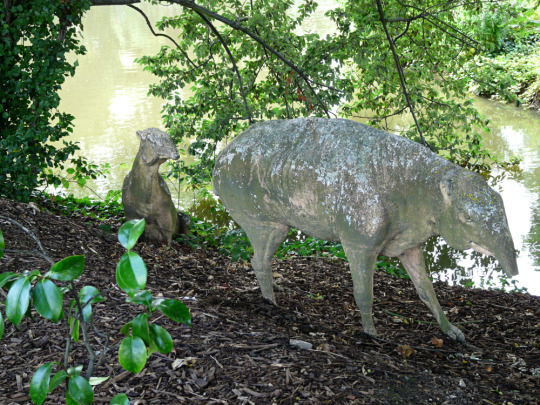
Image from 2009 by Loz Pycock (CC BY-SA 2.0)
Originally represented by three statues, there are two surviving originals of the Eocene-aged palaeotheres depicting Plagiolophus minor (the smaller sitting one) and Palaeotherium medium (the larger standing one).
The sitting palaeothere unfortunately lost its head sometime in the late 20th century, and the image above shows it with a modern fiberglass replacement. Then around 2014/2015 the new head was knocked off again, and has not yet been reattached – partly due to a recent discovery that it wasn't actually accurate to the sculpture's original design. Instead there are plans to eventually restore it with a much more faithful head.
These early odd-toed ungulates were already known from near-complete skeletons in the 1850s, and are depicted here as tapir-like animals with short trunks based on the scientific opinion of the time. We now think their heads would have looked more horse-like, without trunks, but otherwise they're not too far off modern reconstructions.
There was also something exciting nearby:

The recently-recreated Palaeotherium magnum!
This sculpture went missing sometime after the 1950s, and its existence was almost completely forgotten until archive images of it were discovered a few years ago. Funds were raised to create a replica as accurate to the original as possible, and in summer 2023 (just a month before the date of my visit) this larger palaeothere species finally rejoined its companions in the park.
Compared to the other palaeotheres this one is weird, though. Much chonkier, wrinkly, and with big eyes and an almost cartoonish tubular trunk. It seems to have taken a lot of anatomical inspiration from animals like rhinos and elephants, since in the mid-1800s odd-toed ungulates were grouped together with "pachyderms".
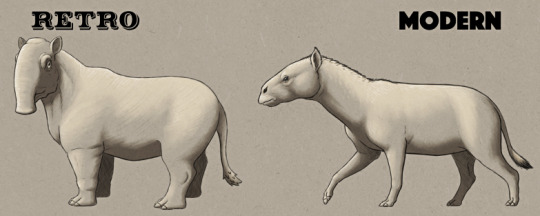
———
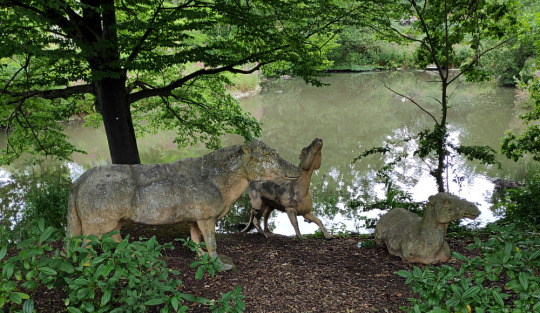
Next is Anoplotherium, an Eocene even-toed ungulate distantly related to modern camels.
(Apparently the sculpture closest to the water is a replica of a now-lost original, recreated from photo references in the same manner as the new Palaeotherium magnum. I can't find a definite reference for when this one was done, though – I'd guess probably during the last round of major renovations in the early 2000s, at the same time as the now-destroyed Jurassic pterosaur replicas?)
Anoplotherium commune is a rather obscure species today, but it was one of the first early Cenozoic fossil mammals to be recognized by science in the early 1800s. Depicted here as small camel-like animals, the three statues are positioned near the water's edge to reflect the Victorian idea that they were semi-aquatic based on their muscular tails.
Today we instead think these animals were fully terrestrial, using their tails to balance themselves while rearing up to reach higher vegetation. Their heads would also have looked a bit less camel-like, but otherwise the Crystal Palace trio are still really good representations.
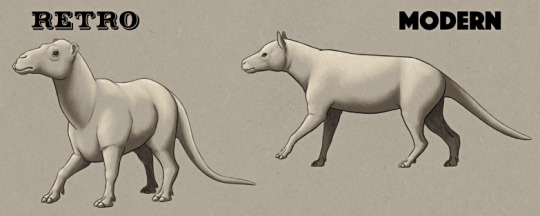
———

Next is a sculpture that's very easy to miss in the current overgrown state.
Who's that peeking over the bushes?
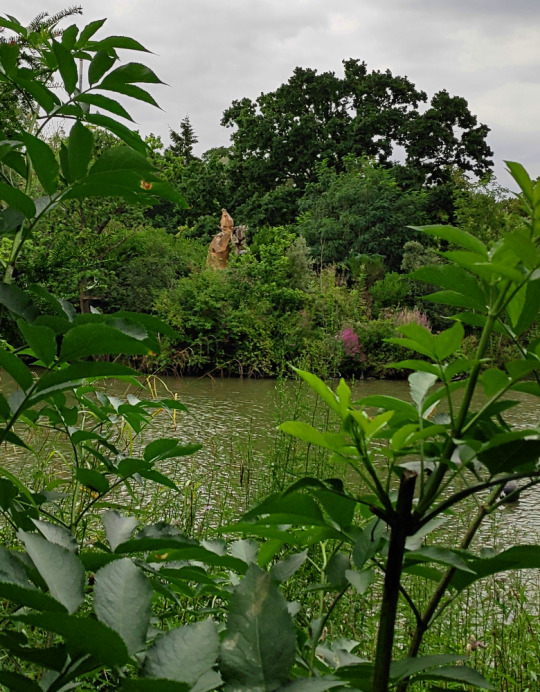
Going all the way around to the far side of the lake reveals a distant glimpse of the Pliocene-to-Holocene giant ground sloth Megatherium.
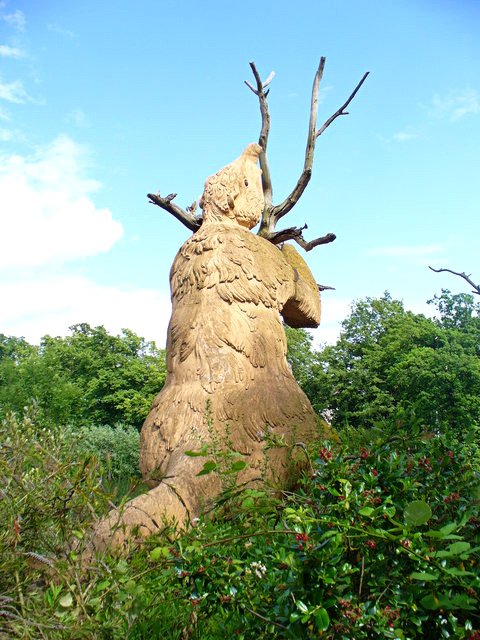
A better view of the Megatherium | "Tree Hugger" by Colin Smith (CC BY-SA 2.0)
Fossils of Megatherium americanum had been known since the late 1700s, but the 1854 Crystal Palace statue was still one of the first life reconstructions of this animal. Its anatomy is actually very close to our modern understanding, depicted with correctly inward-turned feet and sitting upright to feed on a tree with its tail acting as a "tripod".
However, we now know it didn't have a trunk-like nose, but instead probably had prehensile lips more like those of a modern black rhino.
Something weird also appears to have happened to the Crystal Palace Megatherium's hands. Early illustrations of the sculpture all consistently show it with the typical long claws of a sloth, but today it's missing its right hand and its left has only a strangely stumpy paw – suggesting that at some point in the intervening 170 years there was an unrecorded crude repair.
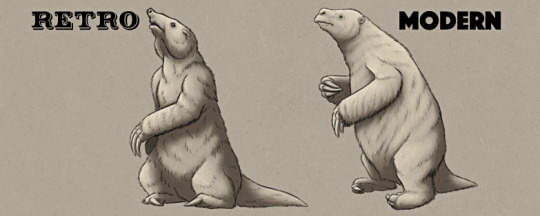
———
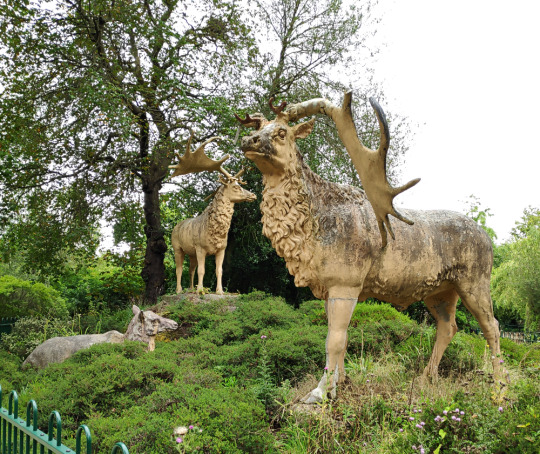
And finally we end the trail with three Megaloceros, the Pleistocene-to-Holocene "Irish Elk" that's actually neither exclusively Irish nor an elk.
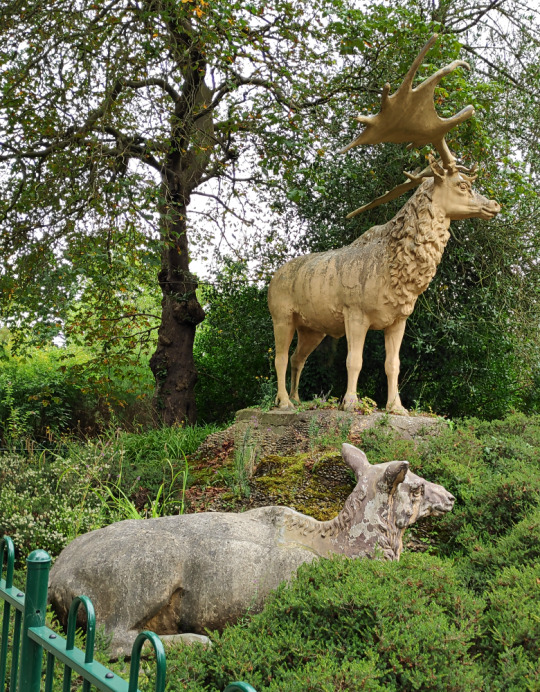
A closer look at the second stag and the doe.
There was originally a fourth giant deer sculpture in this herd, a second resting doe, but it was destroyed sometime during the mid-20th century. The stags also initially had real fossil antlers attached to their heads, but these were removed and replaced with less accurate versions at some point by the mid-20th century.
One of the stags' antlers suffered some damage in 2020, ending up drooping, and since then one antler has either fallen off or been removed.
In the 1850s Megaloceros giganteus was thought to be closely related to deer in the genus Cervus, and so the Crystal Palace reconstructions seem to be based on modern wapiti – specifically in their winter coats, fitting for ice age animals – since both the stags and the doe sport distinctive thick neck manes.
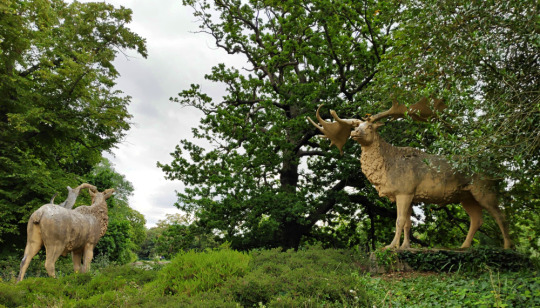
The stags from the other side.
We now know Megaloceros was actually much more closely related to modern fallow deer, and so probably resembled them more than wapiti. Cave art also shows that it had a hump on its shoulders, and even gives us an idea of what its coloration was.
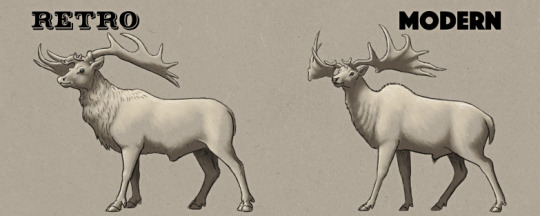
———
…But wait!
There's actually one more thing.
A small statue sitting on the far side of the deer herd, missing its ears, and seemingly representing a Megaloceros fawn.
Except it's actually something very different and very special.
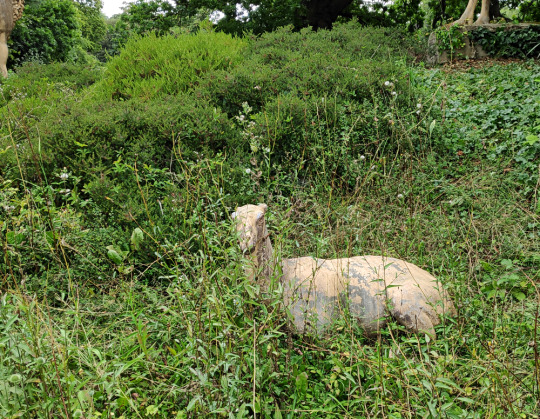
Ceci n'est pas un cerf.
Some recent investigation work revealed some surprising information about the Crystal Palace mammal statues – much like the nearly-forgotten large Palaeotherium, there was originally an entire group of four small Eocene-aged llama-like Xiphodon gracilis that had disappeared from living memory.
There was also no historic record of a fawn with the giant deer, but instead a suspiciously similar-looking sitting sculpture is illustrated among what we now known are the four missing Xiphodon in early records.
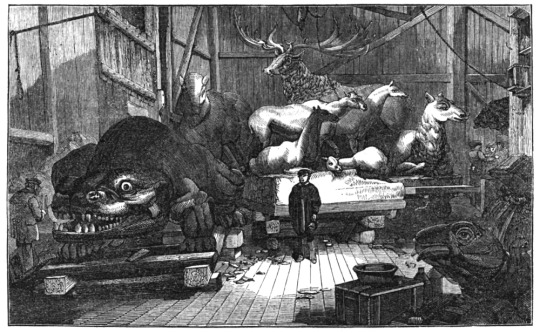
An 1853 illustration of the sculpture workshop. The four Xiphodon are shown in the center, directly in front of a Megaloceros stag and doe. (public domain)
Somewhere in the late 19th or early 20th century three of the Xiphodon must have been completely lost, and the remaining individual was misidentified as a fawn and placed with the giant deer herd.
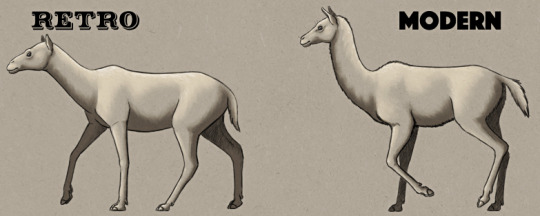
———
Rediscovering a whole extra species among the Crystal Palace statues is exciting, but it also demonstrates just how much of these sculptures' history has gone completely undocumented.
The mammal statues especially seem to have suffered the most out of the "Dinosaur Court", being often overlooked, neglected, disrespected (at one point the Megatherium was inside a goat pen in a petting zoo!), and subjected to cruder repairs. A total of five original statues are now known to be missing from this Cenozoic section – the original large Palaeotherium, the three other Xiphodon, and the second Megaloceros doe – compared to the two pterosaurs lost from the Mesozoic island.
Hopefully the excellent recreation of the lost Palaeotherium magnum is the start of a long overdue new lease of life and conservation attention for all of the Crystal Palace sculptures. It was disappointing seeing them all in such an overgrown state, and with signs of ongoing disrepair in places such as the plant growing out of the big ichthyosaur's back.
But there has been some resurgence of interest and public attention in the Crystal Palace sculptures over the last few years, so with any luck these historic pieces of early paleoart will survive on to their 200th anniversary and beyond, to keep on reminding us of where things began and how far our understanding of prehistoric life has since come.
#field trip!#crystal palace dinosaurs#retrosaurs#i love them your honor#crystal palace park#crystal palace#palaeotherium#anoplotherium#xiphodon#ceci n'est pas un cerf#megaloceros#ungulate#megatherium#ground sloth#mammal#paleontology#vintage paleoart#art#proper art post tomorrow#this took longer than expected#also apologies for my potato-quality camera#i'm an illustrator not a photographer
321 notes
·
View notes
Text

Anoplotherium, Palaeotherium?, Deinotherium, Mylodon & Megatherium illustration published in German magazine Die Gartenlaube (1854), p. 151
https://books.google.co.uk/books?id=DaVLAAAAcAAJ
35 notes
·
View notes
Text

Color pencil-and-ink impression of the strange European Eocene mammal Anoplotherium commune, which may have been related to camels as well as the contemporary oreodont herbivores of North America
#paleoart#paleontology#anoplotherium#cenozoic life#cenozoology#cenozoic#paleoillustration#paleontography#eocene#paleogene
64 notes
·
View notes
Text
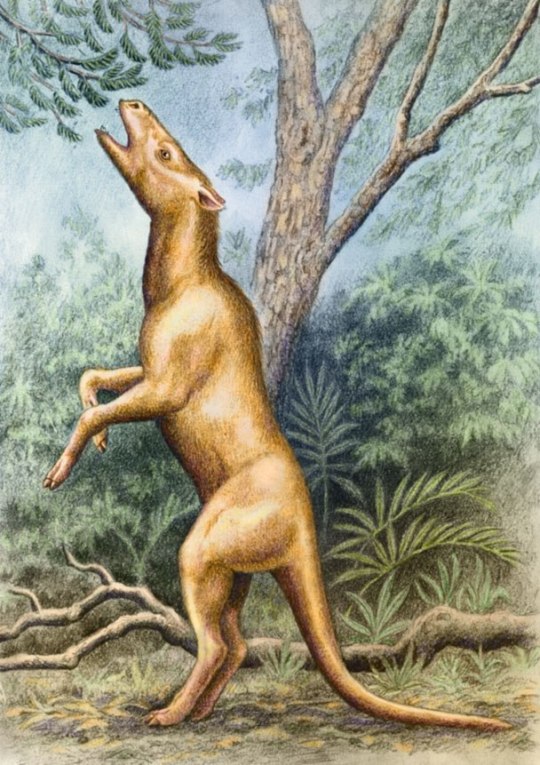
Anoplotherium
Anoplotherium — вимерлий рід травоїдних парнокопитних ссавців, що можливо належав до підряду Tylopoda або був їх близьким родичем, який мешкав у Європі від пізнього еоцену до самого раннього олігоцену. Скам’янілості Anoplotherium вперше були виявлені в гіпсових кар’єрах Парижа в 1804 році і згодом описані французьким натуралістом Жоржем Кюв’є (Georges Cuvier). Це один з перших описаних…
Повний текст на сайті "Вимерлий світ":
https://extinctworld.in.ua/anoplotherium/
#anoplotherium#paleoart#tylopoda#eocene#oligocene#paris#france#herbivores#paleontology#prehistoric#science#prehistory#animals#illustration#art#daily#extinct#fossils#article#арт#палеоарт#палеонтологія#тварини#наука#українська мова#мова#україна#ukraine#ukrainian#creatures
13 notes
·
View notes
Text
Close Up Pussy to Pussy Trib
Extreme big toys hd first time Cristi Ann may be a little too cute
De gatitas a mi chaparrita
en bigo live MisS⭐bonusha⭐
Bdsm Skylar Snow jizzy
Lesbian babe seducing straight friend
Girl with big pussy lips shaves and masturbates with her razor
CUTE AND SEXY PETITE BROWN INDIAN GIRL TIGHT ASS SMALL BOOTY TEASE IN BRA AND PANTIES
Digimon: Female Guilmon Gets Tentacle Fucked
gay bears daddy chub young bears sexy bedroom
#diameter's#ruggy#Anoplotherium#azaleas#trochleate#barge-couple#half-blue#ricercar#karstic#sea-wildered#sempstry#swannish#etic#biblioteca#bluffed#semicontinuous#Lagopus#nonconversableness#uncompromised#four-acre
0 notes
Text




Results from the #paleostream
Asaphestera, Kawingasaurus, Anoplotherium and Palaeospondylus
339 notes
·
View notes
Text

Behold, a creetchur
Meet Stecoteuthops stictis, the "spotted standing squid-face". It's one of the most important creatures for my in-the-works Spec project. Basically the premise is that many years in the future, humanity colonized a distant desert planet (Spero) with the intent on terraforming it to become a new colony. However, something went horribly wrong, and humanity was wiped out, leaving behind only the livestock and crops they brought with them. This transitional form lives about 60 million years post-cataclysm and is a descendant of the Dromedary Camel (Camelus dromedarius).
Stecoteuthops is part of a particularly successful radiation of camels which possess subcutaneous osteoderms for defense against predators. In this genus, the osteoderms along the midline of the back have formed tall struts which support a decorative sail of skin. This sail is used for display and also to break up its outline in its woodland home, helping the animal to hide from predators; males have much taller sails than females.
This animal is most similar in form and function to the ancient stem-camel Anoplotherium, possessing a muscular, elongated tail which is used to support the body while browsing. Their pincer-like forelimbs can be used to grasp branches and pull them down to access fresh fruits and tender new leaves. They are obligate herbivores, and fruit forms over 70% of their diet - their dextrous, almost tentacular lips are used to grasp and manipulate ripe fruit, and are lined with cornified papillae to ensure a firm grip. Their fur is greenish-blue, the result of a novel pigment derived from Biliverdin which evolved near the very base of the camel radiation, shortly after colonization.
Stecoteuthops is important to this world because it represents a transitional form between large, ground-dwelling camels and smaller, arboreal forms. Although Stecoteuthops itself does not climb, its grasping feet, small size, and muscular tail are all preadaptations for arboreality, and its descendants will clamber about the canopy in search of fresh fruit. It is this lifestyle which will enable the camels to survive the coming mass extinction, priming them to diversify into one of the dominant clades on the planet Spero.

#speculative biology#spec bio#speculative evolution#spec evo#speculative fiction#creature design#creature#seed world#Vicis Aeternum#Spero
142 notes
·
View notes
Text

Ungulate (Anoplotherium), Dictionnaire Universel D'histoire Naturelle (1892) - Charles Dessalines D’Orbigny
#Wonder Rooms#Cabinet of Curiosities#Public Domain#19th Century#Charles Dessalines D’ Orbigny#Dictionnaire Universel D'histoire Naturelle#Scientific Illustration#Natural History#Extinct Animals#Paleontology#Fossils#Zoology#Animalia#Mammalia#Artiodactyla#Anoplotheriidae#Anoplotherium
36 notes
·
View notes
Photo

anoplotherium commune, a species best known for occurring at @cpdinosaurs but also very interesting in its own right: a rearing, barrel-chested 3-toed artiodactyl.
2 notes
·
View notes
Photo

TAPIR-LIKE ANIMALS, EOCENE PERIOD, Xiphodon, Anoplotherium, Palaeotherium - high resolution image from old book.
0 notes
Text

"Paysage idéal de la période éocene" [Ideal landscape of the Eocene period] by Edouard Riou, from La terre avant le déluge [The world before the deluge] by Louis Figuier, 1863
#edouard Riou#la terre avant le deluge#world before the deluge#louis figuier#1863#Eocene#Trionyx#Anoplotherium#Palaeotherium#Xiphodon#Tantalus
4 notes
·
View notes
Photo
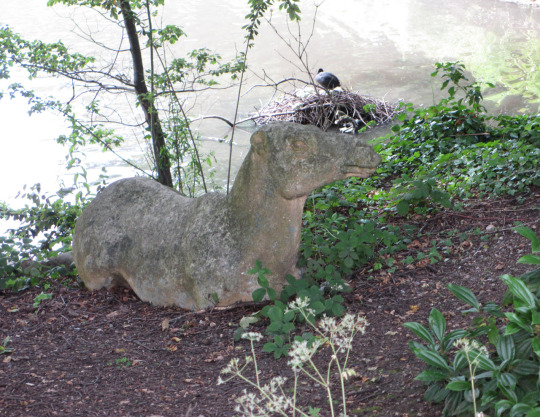
How accurate is the Anoplotherium at Crystal Palace Park?
Anoplotherium was a tylopod, a member of the clade of Artiodactyls that includes the modern camels. The animal is known from good fossils, so this reconstruction may be very close to the real thing: a generalized, camel-like forager.
21 notes
·
View notes
Photo

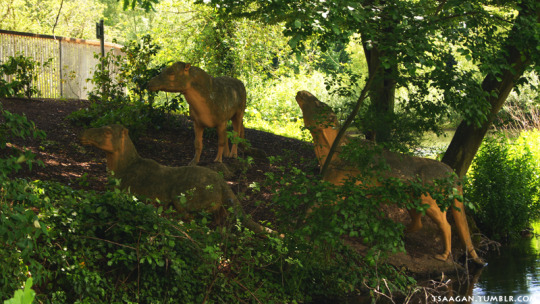
Photos of Crystal Palace Park from my trip to London 17.6.2012
These are Anoplotheriums.
#crystal palace park#london#anoplotherium#not dinosaurs#extinct animals#mammals#benjamin waterhouse hawkins#richard owen#my photography
30 notes
·
View notes